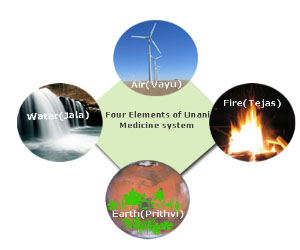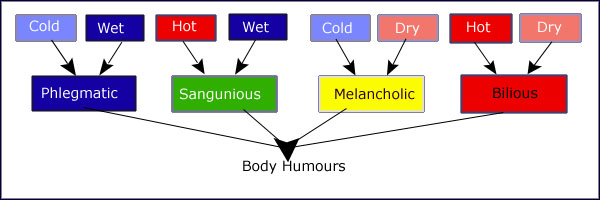|
|
Introduction
History
Body Humours
Standard Facts About humours
Basic Components
|
|
Introduction:
|
Unani Medicine is based on the Greece philosophy. According to Basic Principals
of Unani the body is made up of the four Basic elements These Elements Are:-
|
|
These Elements have different Temperaments
|
 |
After mixing and interaction of four elements a new compound having new temperament
comes into existence i.e. Hot Wet, Hot Dry, Cold Wet, Cold Dry. The body have the
Simple and Compound Organs which got their nourishment through four Humours i.e.
Blood, Phlegm, Yellow Bile, Black Bile. The humour also assigned temperament as
blood is hot and wet, Phlegm is cold and hot, yellow bile is hot and dry and black
bile is cold and dry.
|
|
History: |
|
Unani medicine was originated in Greece and its founder was great philospher &
Physician ,Hippocrates. He was the first Unani Physician who opened the education
of Medicine to all communities, so he is known as the father of medicine in Allopathic
also because modern medical science was developed on the foundation of Hippocratic
philosophy of health and disease. Before Hippocrates it was restricted to the Aesclabius
family only.
Unani system of medicine was introduced to India by the Arabs, and soon it
took firm roots in the soil. The Delhi Sultans, the khiljis, the Tughlaqs and the
Mughal Emperors provided state patronage to the scholars and even enrolled some
as state employees and court physicians. The system found immediate favour with
the masses and soon spread all over the country. During the therteenth and seventeenth
century Unani Medicine had its heyday in India. Among those who made valuable contributions
to this system in the period were, to name only a few, Abu Bakr bin Ali Usman kashani,
Sadruddin Damashqui, Bahwa bin khwas khan, Ali Geelani, Akbar Arzani and Mohammad
Hashim Alvi Khan.
(Central Council For Research In Unani Medicine,India)
|
|
460-377 BC |
Unani medicine was originated in Greece and its founder was great philospher &
Physician ,Hippocrates |
|
384-322 BC |
Aristotle laid down foundation of Anatomy & physiology. |
|
130-201 BC |
Galen Jalinoos contributed a lot to the Unani Medicine. |
|
Dioscorides |
Dioscorides was the famous physician in the Ist Century AD. He was famous for his
book on Ilmuladviya(Pharmacology) named as Kitabulhashayash.
|
|
717-813AD |
Jabir bin Hayyan who was settled in the Arab as Royal physician was a famous physician
and Chemist. He was the first who had described Chemistry. |
|
810-895AD |
Ibne Raban Tabari was famous physician and wrote a book Firdous ul Hikmat
and introduced concept of official formulary |
|
865-925 AD |
Abu Bakar Zarakariya Razi or Rhazes etc. He wrote the book "Alhawi fit tibb".
He was first scholar who described the concept of Acquired Immunity by his experiments
in the article |
|
980-1037AD |
The very eminent scholar of this period was Bu Ali Sina. He was the great philosopher,
physician of the Arab. He gave a final shape to the Unani medicine & redefined
many concepts based on his clinical experiences. His book Alqanoon or (The canon
of medicine) was an internationally accepted book on medicine, which was taught
in European countries till the 17th century. During the Spanish Period The Arabs
have introduced Unani medicine in the Spain in the patronage of Spanish Ruler, many
scholars contributed a lot to Unani Medicine for instance |
|
946 -1036AD |
Abul Qasim Zohravi was the famous surgeon was attached to Royal Hospital of
Cordoba. He wrote a famous book on surgery "Al Tasreef" |
|
965-1039AD |
Ibn-e-Haisham was a renowned scientist and Unani physician from Syria laid down
the foundation of optics in his famous book"Kitabul Manazir" |
|
1091-1162AD |
Ibn-e-Zohar was a renowned physician and Scholar. He was known for his famous
book "Kitabul Tasreef". |
|
1126-1198AD |
Ibn Rushd was famous for his book on Basic Principals of Unani Medicine known
as Kitabul Kulliyat
|
|
1197-1248AD |
Ibne Baitar was Pharmacognosist and Botanist. His famous book on extensive
survey and experiments on Single Drugs of Plant origin Kitabul jameul Mufradat.
Was widely acclaimed.
|
|
1210-1288 AD |
Ibn-e-Nafees was the first scientist who described the blood pulmonary circulation
and prescribed anatomy as a separate chapters. Present Indian Context Unani medicine
in India was introduced in 1351 AD by Arabs. The first known Hakim was Zia Mohd
Masood Rasheed zangi. Unani Medicine soon got acceptance by the masses due to its
efficacy and nontoxicity of the drugs.
|
|
1725-1807 |
Hakim M. Shareef Khan A famous Hakim of Delhi in Mughal Period. He was famous
for his book Ilaj ul Amraz. |
|
1864-1927 |
Hakim Ajmal Khan Hkm Ajmal Khan. was renowned Hakim,scientist,politician and
freedom fighter and a great patriot. He has established Unani and Ayurvedic College
at Karol Bagh Delhi. He is remembered as Masihul Mulk Hkm Ajmal Khan.He was the
first person who opened the door of research in Indian Systems of medicine and under
his supervision Asarol (Rauwolfia serpentina) was analysed and isolated various
alkaloids i.e. Ajmaloon, Reserpine etc and most effective drug for Hypertension
was introduced in world.
|
|
1872 |
The first institution of Unani medicine was established in as Oriental College
at Lahore. |
|
April 1894-9th January 1976 |
Hakim kabeeruddin was very dedicated scholar of Unani Medicine . He was translated
88 Unani books of Arabic and Persian languages into Urdu. Which was the greatest
achievement. Due to this achievements today, the Unani colleges in India are in
existence. |
|
|
Thereafter many institution came into existence. Post independence India period
After independence Govt. of India at first constituted Unani pharmacopoeia Committee
in 1964.,consisting of Unani experts and scientist with a view to maintain uniformity
in the standards of drugs and to prescribe standards for compound formulations.
And also to prescribe tests for identity, purity, efficacy and quality of the drugs.
Pharmacopoeia Laboratory of Indian Medicine at Ghaziabad was established under Govt.
of India to workout standards and drug testing for Indian System of Medicine at
national level. Govt. of India has also established Central Council of Indian Medicine
,an statutory body,for laying down standards and maintaining uniform standard of
education in the Indian System of Medicine including Unani and to regulate the practices
in Indian System of Medicine. In order to develop high standards of education and
research in Unani Medicine at national level a National Institute of Unani Medicine
has been established at Bangalore in 1983 in collaboration with the Govt. of Karnataka
which provided 55 acres of land for the Institute. In addition to these developments
Central Council for Research in Indian Medicine was established in 1969.During 1978
these Council were bifurcated into separate Central Councils as such Central Council
for Research in Unani Medicine was established in 1979, with a view to initiate
,guide, aid, develop, coordinate scientific research in different aspects of fundamental
and applied Unani System of Medicine. |
|
|
Different Temperaments And Body Humours |
 |
|
Standard Facts About Humours |
|
Humours |
Body Substance |
Produced By |
Elements |
Qualities |
Complexion &Body
|
Personality |
|
Sanguious |
Blood |
Liver |
Air |
Hot+Wet |
Red Cheeked, Corpulent |
Amorous, Happy, Generous, Optimistic, Irresponsible |
|
Bilious |
Yellow Bile |
Spleen |
Fire |
Hot+Dry |
Red-Haired,Thin |
Violent, Vengeful, Short-tempered, Ambitious |
|
Phlegmatic |
Phlegm |
Lungs |
water |
Cold+Wet |
Corpulent |
Sluggish, Pallid, Cowardly |
|
Melancholic |
Black Bile |
Gall Bladder |
Earth |
Cold+Dry |
Sallow, Thin |
Introspective, Sentimental, Gluttonous |
|
|
Basic Components
|
|
According to the Unani medicine system as it stands today, the human body is composed
of seven natural and basic components called 'Umoor e Tabaiyah' which are responsible
for maintenance of health. These are : -
- Arkan (Elements)
- Mizaj (Temperament)
- Akhlaat (Humours)
- Aaza (Organs)
- Arwah (Vital forces or Neuro)
- Quwa (Faculties)
- Afaal (Functions)

The loss of any one of these basic components or alteration in their physical state
could lead to disease, or even death. It is highly essential to consider all these
factors so as to reach the correct diagnosis and consequently the correct line of
treatment.
|
|
Best viewed in IE5.0+ and (1024X768) Resolution. Life Science Medical Center © 1999-2006
Phone:
scienceoflife.com - Window to the Future of Medicine ®
|
|